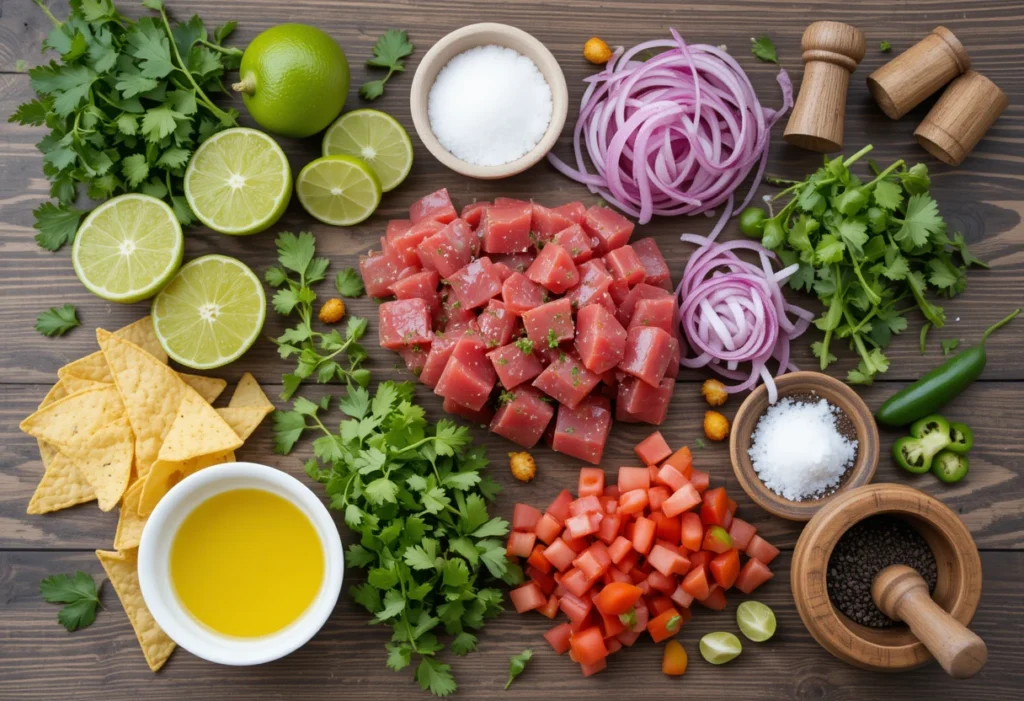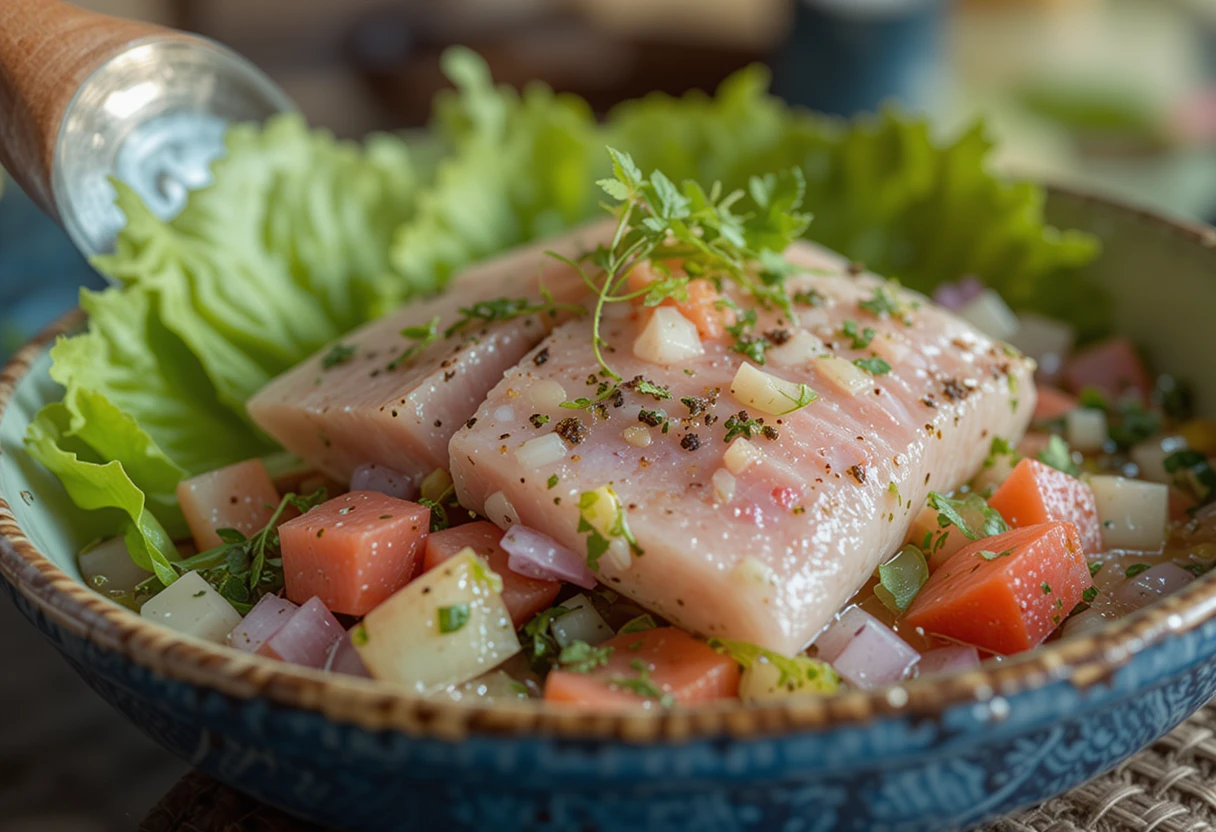1. Introduction: The Art of Bluefin Tuna Ceviche
Picture this: a sunny afternoon, a chilled glass of white wine in your hand, and a plate of fresh, tangy bluefin tuna ceviche in front of you. The citrus aroma hits first, followed by the vibrant mix of flavors—lime, chili, cilantro, and the buttery richness of bluefin tuna. There’s something magical about a well-made ceviche, isn’t there?
But here’s the catch: not all fish are created equal when it comes to ceviche. Bluefin tuna, one of the most sought-after species, requires careful selection, preparation, and handling. Unlike other fish, bluefin has a delicate balance of fat and texture that can either elevate your dish or ruin it if handled improperly.
If you’re looking to create the perfect bluefin tuna ceviche, you’ve come to the right place. This guide will take you through every step—from selecting the highest quality tuna to marinating it just right. You’ll also learn the precautions you must take to ensure safety and sustainability.
By the end, you’ll be confident in your ability to craft a ceviche that rivals even the best Peruvian or Mexican seafood spots. Ready? Let’s dive in!
Table of Contents
2. Understanding Bluefin Tuna for Ceviche
2.1 What Makes Bluefin Tuna Ideal for Ceviche?
Not all fish work well in ceviche, but bluefin tuna stands out for several reasons:
- Rich Flavor & Buttery Texture – Unlike white fish, bluefin tuna has a deep umami taste with a silky, melt-in-your-mouth texture.
- High Fat Content – The natural oils in bluefin enhance the marinade’s citrusy tang while adding a luxurious mouthfeel.
- Protein-Packed & Nutrient-Rich – Loaded with omega-3 fatty acids, bluefin tuna supports heart health while delivering a protein punch.
- Firmness & Structure – Unlike softer fish that break down quickly, bluefin holds its shape, making it perfect for ceviche.
However, because of its high value and conservation concerns, sourcing it responsibly is crucial.
2.2 Different Grades of Bluefin Tuna
Not all bluefin tuna is sushi-grade, which is the gold standard for raw consumption. Let’s break it down:
- Sushi-Grade (Sashimi-Grade) Tuna
- Best choice for ceviche – Flash-frozen at extremely low temperatures to kill parasites.
- Firm, deep red flesh with a fresh ocean scent.
- Typically sourced from high-quality suppliers.
- Non-Sushi-Grade Tuna
- Not safe for ceviche unless thoroughly cooked.
- Often sold as fresh steaks for grilling.
- May have higher risks of bacterial contamination.
- Best Cuts for Ceviche
- Otoro (Fatty Belly Cut) – Exceptionally rich, but may be too oily for some.
- Akami (Lean Cut) – Most commonly used; has a deep red color and a clean, fresh taste.
When choosing tuna, opt for sushi-grade and always verify with your supplier.
3. Sourcing and Selecting the Best Bluefin Tuna
3.1 Where to Buy High-Quality Bluefin Tuna
Finding top-tier bluefin tuna can be tricky, but here’s where you can source it:
- Trusted Seafood Markets – Look for specialty stores with a focus on sushi-grade fish.
- Japanese Fish Markets – These markets handle bluefin with extreme care and sell only the best cuts.
- Online Seafood Suppliers – Many reputable online retailers ship flash-frozen, sushi-grade bluefin directly to your door.
- Local Fishmongers – A knowledgeable fishmonger can help you choose the freshest tuna available.
3.2 How to Identify Freshness in Bluefin Tuna
When selecting your tuna, use these freshness indicators:
| Feature | Fresh Tuna Should Be… | Avoid If… |
|---|---|---|
| Color | Deep red, vibrant | Brown, dull, or gray |
| Texture | Firm, smooth | Mushy or sticky |
| Smell | Clean, ocean-like | Sour, ammonia-like |
| Packaging | Vacuum-sealed, well-chilled | Sitting in liquid, exposed |
A simple test: Press the flesh gently—if it springs back, it’s fresh. If it stays dented, move on.
4. Precautions When Using Bluefin Tuna in Ceviche
4.1 Food Safety Concerns
Eating raw fish always comes with risks, so here’s how to minimize them:
- Use Sushi-Grade Tuna – This ensures the fish has been frozen at ultra-low temperatures to eliminate parasites.
- Freeze Before Use – If you’re unsure about your tuna’s safety, freeze it at -4°F (-20°C) for at least 7 days before using it in ceviche.
- Proper Thawing – Thaw frozen tuna slowly in the fridge to prevent bacterial growth.
- Use Fresh Citrus Juice – The acidity of lime and lemon helps kill surface bacteria.
4.2 Sustainability and Ethical Considerations
Bluefin tuna is one of the most overfished species in the world, which means you must be mindful when purchasing it.
- Choose Certified Sustainable Options – Look for Marine Stewardship Council (MSC) or Aquaculture Stewardship Council (ASC) labels.
- Opt for Smaller Quotas – Some suppliers follow strict fishing limits to ensure sustainability.
- Consider Alternatives – If sustainability is a concern, try using yellowfin tuna or albacore, which have similar textures but lower environmental impact.
5. Preparing Bluefin Tuna for Ceviche
5.1 Cleaning and Cutting the Tuna
You’ve got your high-quality bluefin tuna—now let’s prep it properly:
Step-by-Step Cleaning Guide
- Gently dry the tuna with a paper towel to eliminate any extra moisture.
- Trim away any sinew (the tough white membrane).
- Utilize a sharp knife for neat and accurate cuts.
How to Cut Tuna for Ceviche
- Small Cubes (½-inch pieces) – Best for evenly absorbing the marinade.
- Thin Slices (Tiradito-style) – A Peruvian approach that results in delicate, sashimi-like bites.
5.2 Marination Process and Key Ingredients
Marination is the heart of ceviche—too long, and your fish turns mushy. Here’s how to do it right:
- Time: 10-20 minutes max (any longer and the fish “overcooks”).
- Citrus Selection: Fresh lime and lemon juice—never bottled!
- Salt & Seasoning: Enhances the natural flavors.
- Additional Ingredients: Red onion, cilantro, chili peppers, and avocado.
Table: Essential Ingredients and Their Roles
| Ingredient | Purpose in Ceviche |
|---|---|
| Bluefin Tuna | The star protein |
| Lime Juice | Cures and flavors the fish |
| Red Onion | Adds crunch and sweetness |
| Cilantro | Brightens up the dish |
| Chili Peppers | Brings heat and spice |
| Avocado | Adds creamy contrast |

6. Expert Tips for Enhancing Bluefin Tuna Ceviche
6.1 Balancing Flavors and Textures
Making great ceviche is all about balance. You want a mix of acidity, spice, sweetness, and texture to create the perfect bite. Here’s how you can elevate your bluefin tuna ceviche:
- Acidity: Fresh lime and lemon juice are key, but don’t overdo it. Too much acid can overpower the tuna’s natural flavor.
- Heat: Choose between mild (jalapeños), medium (serrano peppers), or intense heat (habanero or aji amarillo).
- Sweetness: A touch of diced mango or orange juice can counterbalance acidity and spice.
- Texture: A great ceviche isn’t just about the fish—it’s about the crunch! Add thinly sliced red onion, crispy corn, or plantain chips for extra texture.
- Umami Boost: A splash of soy sauce or a pinch of seaweed flakes can enhance the tuna’s natural umami taste.
Pro Tip:
Want extra depth? Let the onions marinate in lime juice for 5 minutes before adding them to the ceviche. This softens their bite while keeping their crunch.
6.2 Pairing Bluefin Tuna Ceviche with Drinks and Sides
What’s a delicious ceviche without the perfect drink and side?
Best Drinks to Pair with Bluefin Tuna Ceviche
- Pisco Sour – A classic Peruvian cocktail that complements citrusy dishes.
- Crisp White Wines – Sauvignon Blanc, Albariño, or Pinot Grigio balance acidity and freshness.
- Citrus-Based Cocktails – Margaritas or mojitos enhance the lime and chili flavors in ceviche.
- Cold Beer – A light lager or pale ale works great to cleanse the palate.
Perfect Side Dishes
- Tostadas – Crunchy corn tostadas provide a perfect base for scooping ceviche.
- Sweet Potato – A common side in Peruvian ceviche, balancing acidity with sweetness.
- Plantain Chips – A tropical twist with a crispy texture.
- Coconut Rice – If you want a fuller meal, this mild-flavored side pairs beautifully.
7. Common Mistakes to Avoid
Even seasoned chefs make mistakes when preparing ceviche. Avoid these common pitfalls:
7.1 Over-Marinating the Tuna
A common misconception is that longer marination equals better flavor. But with bluefin tuna, 20 minutes is the max.
Why?
- Over-marinating results in a mushy texture.
- Excess acidity can make the fish overly tough.
Solution: If you love stronger citrus flavor, reserve some fresh lime juice and drizzle it over just before serving.
7.2 Using the Wrong Type of Fish
Not all tuna is suitable for ceviche. If you use non-sushi-grade bluefin, you risk foodborne illnesses.
Mistake:
Buying supermarket-grade tuna steaks.
Solution:
- Always ask for sushi-grade bluefin tuna at the fish market.
- If unsure, freeze the fish yourself at -4°F (-20°C) for at least 7 days.
7.3 Improper Storage and Handling
Ceviche is best served fresh, but if you must store it, here’s how:
Storage Guidelines:
| Storage Method | Maximum Time | Notes |
|---|---|---|
| At Room Temperature | 1 hour | Best for serving immediately. |
| Refrigerated | 24 hours | Flavor changes over time, best eaten fresh. |
| Frozen | Not recommended | Freezing changes texture, making it less enjoyable. |
Never leave ceviche at room temperature for too long. The raw fish can develop bacteria quickly if not kept cold.
8. Conclusion: Elevating Your Ceviche Game
You now have all the tools to create restaurant-quality bluefin tuna ceviche at home! From choosing the right fish to balancing flavors and avoiding common mistakes, this guide ensures you get the most out of your ceviche experience.
Key Takeaways:
✅ Use sushi-grade bluefin tuna for the best texture and safety.
✅ Marinate for 10-20 minutes—never longer.
✅ Balance acidity, heat, and sweetness for a perfect flavor profile.
✅ Pair ceviche with crisp wines, cocktails, or cold beer for the ultimate experience.
✅ Store properly and consume within 24 hours for the freshest taste.
Now it’s your turn! Get your hands on some fresh bluefin tuna, grab your limes, and start experimenting with your own ceviche masterpiece. Once you do, share your results and tag your favorite seafood lovers!
9. Frequently Asked Questions (FAQs)
9.1 Is Bluefin Tuna Safe to Eat Raw in Ceviche?
Yes—but only if it’s sushi-grade. Bluefin tuna is a high-quality fish, but consuming it raw requires proper handling and freezing to eliminate parasites.
9.2 How Long Should I Marinate Bluefin Tuna for Ceviche?
Marinate for 10-20 minutes maximum. Anything longer and the fish overcooks in the acid, losing its fresh, tender texture.
9.3 What Are Some Sustainable Alternatives to Bluefin Tuna?
If you’re concerned about overfishing, try:
- Yellowfin Tuna – A more sustainable option with a similar texture.
- Mahi-Mahi – A mild fish that works well in ceviche.
- Arctic Char or Salmon – These offer rich flavors while being more eco-friendly.
9.4 Can I Store Leftover?
Ceviche is best eaten fresh, but if necessary:
- Refrigerate immediately in an airtight container.
- Consume within 24 hours for the best flavor.
- Do not freeze—freezing ruins the texture.
9.5 What’s the Best Drink to Pair with Bluefin Tuna Ceviche?
- White Wine (Sauvignon Blanc, Albariño)
- Pisco Sour or Margarita
- Cold Lager or Pale Ale
Final Words
If you’ve ever wanted to master ceviche, this is your chance. Follow these steps, use the right ingredients, and you’ll be amazed at how restaurant-quality ceviche is possible right in your kitchen.
Now, it’s your turn: What’s your favorite way to enjoy ceviche? Drop your thoughts in the comments or share your own recipe tweaks!
